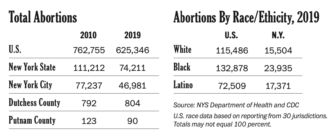CDC shows most are in their 20s with children
The U.S. Supreme Court’s ruling on June 24 eliminating a constitutional right to abortion established by Roe v. Wade in 1973 had been expected ever since a draft of the decision was leaked in May. But it still shocked local residents.
The next day, First Presbyterian Church in Cold Spring posted to its Facebook page a video of Presbyterian Church U.S.A. officials affirming their organization’s support for abortion rights. In Beacon, Aimee deSimone, the owner of Berte, a retail shop, organized a fundraiser to support the National Network of Abortion Funds, which provides money for travel, lodging and other abortion-related expenses.
“We all knew this was coming, but once it was actually official it felt like a slap on every woman’s face and a revocation of basic freedoms,” said deSimone on Monday (June 27). “I was angry; I’m still angry.”
Planned Parenthood of Greater New York said it was increasing appointment slots by 20 percent at its 23 clinics, including one in Newburgh, to accommodate an expected influx of women from states with abortion bans.

A woman from Oklahoma, one of the states where an abortion ban took effect with the Supreme Court’s decision, had already traveled to one of PPGNY’s clinics in New York City because she could not get an appointment at home, said Gillian Dean, chief medical officer for PPGNY.
The decision will affect many more “people who do not own cars, people who can’t afford the incredibly high price of filling up their gas tank over and over again on a long trek, people who can’t afford to fly to an abortion-access state like New York, people who don’t have child care or the support of loved ones to make a trip like that,” she said.
Who are these women?
Updated abortion data released by the Centers for Disease Control and Prevention in November provides a snapshot: mostly women in their 20s who are unmarried and already have children.
The data is from 2019 and is based on reporting from health agencies in 47 states, New York City and the District of Columbia. (California, Maryland and New Hampshire are not included.) Forty-eight of those jurisdictions have reported data every year since 2010.
The statistics show that:
- About 18 percent of all pregnancies end in an induced abortion.
- The rate of reported abortions per 1,000 women declined from 2010 to 2019, to 11.4 percent from 14.4 percent.
- Nearly 80 percent of abortions were performed within nine weeks of gestation and 93 percent within 13 weeks.
- The CDC identified two abortion-related deaths for 2018, the most recent year available. There were 47 deaths from abortions, including 19 from illegal procedures, reported in 1973, the year Roe v. Wade was decided.
- Women in their 20s accounted for 56.9 percent of abortions, as they have generally done since 2010. Teenagers 15 years old and younger, and women 40 and older, had the lowest percentages of abortions.
- From 2010 to 2019, abortion rates fell for all age groups, but by the largest for adolescents younger than 15 (decrease of 60 percent) and teens between 15 and 19 (50 percent).
- For 30 jurisdictions reporting race and ethnicity data for 2019, Black women (38.4 percent) and white women (33.4) accounted for the highest percentages of abortions. Latino women represented 21 percent of abortions.
- Compared to white women, abortion rates were 3.6 times higher for Black women and 1.8 times higher for Latino women.
- Marital status data reported by 42 jurisdictions showed that 85.5 percent of women receiving abortions in 2019 were unmarried.
- Nearly 45 percent of women had one or two children, 40 percent were childless and 15 percent had three or more children.

